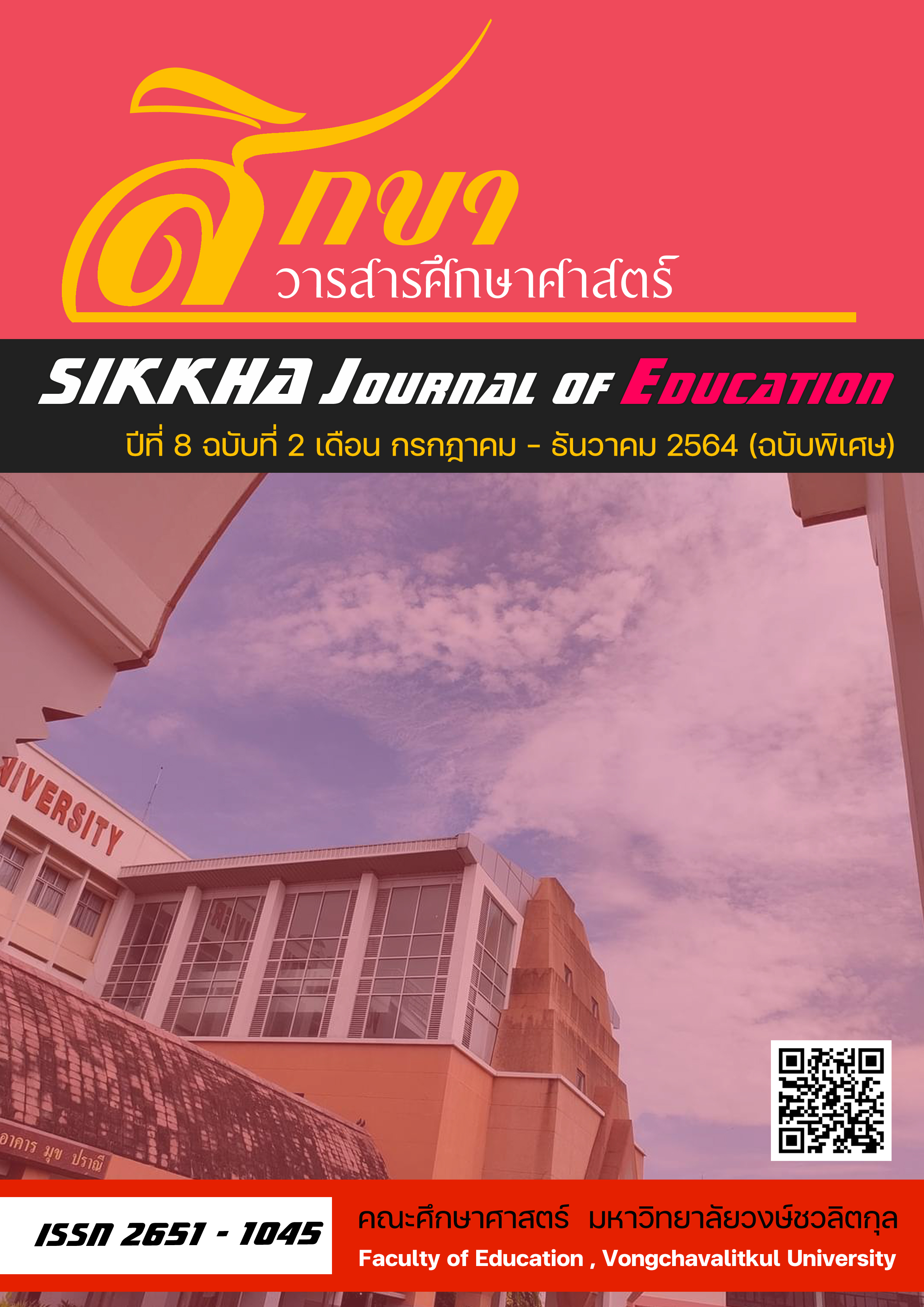การตรวจสอบคุณสมบัติการวัดทางจิตวิทยาด้วยการวิเคราะห์โครงข่าย ของแบบวัดบุคลิกภาพด้านมืด ฉบับย่อภาษาไทย 27 ข้อ (SD3-TH)
คำสำคัญ:
บุคลิกภาพด้านมืด, แบบวัดบุคลิกภาพด้านมืดฉบับย่อ, คุณสมบัติการวัดทางจิตวิทยา, ภาษาไทยบทคัดย่อ
การศึกษาเรื่องบุคลิกภาพด้านมืดของมนุษย์ได้รับความสนใจจากนักวิจัยทั่วโลก ในส่วนแบบวัดบุคลิกภาพด้านมืดฉบับย่อ (The Short Dark Triad: SD3) นั้นได้รับการพัฒนาและแปลออกเป็นหลายภาษารวมทั้งภาษาไทย อย่างไรก็ตามแบบวัดฉบับภาษาไทยได้ตัดข้อคำถามจากแบบวัดต้นฉบับภาษาอังกฤษ 27 ข้อ ให้เหลือเพียง 15 ข้อ แม้โมเดลการวัดจะมีความสอดคล้องกลมกลืนและมีค่าความเชื่อมั่นในระดับสูง แต่เนื้อหาบางประการได้ถูกตัดทิ้งไป การศึกษาในครั้งนี้มีวัตถุประสงค์การวิจัยเพื่อตรวจสอบคุณสมบัติการวัดทางจิตวิทยาของแบบวัดด้วยการวิเคราะห์องค์ประกอบเชิงยืนยันและการวิเคราะห์โครงข่ายของข้อคำถาม โดยใช้กลุ่มตัวอย่างเป็นนักศึกษาระดับปริญญาตรี จำนวน 212 คน
ผลการศึกษาพบว่าโมเดลการวัดใน 3 องค์ประกอบ (Machiavellianism, Narcissism, Psychopathy) มีความสอดคล้องกลมกลืนกับข้อมูลเชิงประจักษ์ในระดับปานกลาง (χ2/df = 1.98, p = .06, ค่า CFI = .77, ค่า TLI = .74, RMSEA = .06) มีค่าความเชื่อมั่นอยู่ในระดับสูงกว่าเกณฑ์ที่ยอมรับได้ทั้ง 3 องค์ประกอบ การวิเคราะห์โครงข่ายพบการซ้อนทับของข้อคำถามระหว่างด้าน Machiavellianism และ Psychopathy และพบข้อคำถามอย่างน้อย 8 ข้อ ที่สามารถปรับปรุงในการวิจัยครั้งต่อไปเนื่องจากไม่มีความสัมพันธ์กับข้อคำถามอื่นๆ ในโครงข่ายข้อคำถามด้านเดียวกัน
เอกสารอ้างอิง
ชินัณ บุญเรืองรัตน์ และ หวง เฟย. (2561). แบบวัดบุคลิกภาพด้านมืด (Short Dark Triad: SD3-TH) การตรวจสอบคุณสมบัติการวัดทางจิตวิทยาฉบับภาษาไทย. ศึกษาศาสตร์สาร มหาวิทยาลัยเชียงใหม่. 2(1), 1-17.
Atari, M., & Chegeni, R. (2016). Assessment of Dark Personalities in Iran: Psychometric Evaluation of the Farsi Translation of the Short Dark Triad (SD3-F). Personality and Individual Differences, 102, 111-117.
Balakrishnan, V., Khan, S., Fernandez, T., & Arabnia, H. R. (2019). Cyberbullying Detection on Twitter using Big Five and Dark Triad Features. Personality and Individual Differences, 141, 252-257.
Bentler, P. M. (1995). EQS Structural Equations Program Manual (Vol. 6): Multivariate Software., CA: Encino.
Boonroungrut, C., Dechporm, S., Oo, T. T., & Kim, O. (2018). A Mediation Study of Human Dark Personality and the Prediction of Students’ Monetary Attitudes. The Journal of Basic and Applied Research, 4(3), 49-57.
Boonroungrut, C., & Huang, F. (2019). Dark Triad Personality and Money Management Intention between Self-support and Load Students in Thailand. (Ph.D. Developmental and Educational Psychology), Central China Normal University,
Boonroungrut, C., & Huang, F. (2020). Measurement Validation for Money Nanagement Intention Based on the Transtheoretical Model of Behavior Change. The Journal of Behavioral Science, 15(2), 38-53.
Boonroungrut, C., Huang, F., & Dechprom, S. (2020). Dark Triad Personality Impact on Saving and Spending Attitude: a Multi-group Analysis Between Self-support and Loan Students. Kasetsart Journal of Social Science, 41(3), 76-84.
Boonroungrut, C., & Toe Toe, O. (2017). Dark Triad Trends in Personality Studies: Systematic Review with Bibliometric Network Analysis. Journal of Humanities and Social Sciences Mahasarakarm University, 36(6), 63-76.
Buckels, E. E., Jones, D. N., & Paulhus, D. L. (2013). Behavioral Confirmation of Everyday Sadism. Psychological Science, 24(11), 2201-2209.
Chisasa, J. (2014). The Finance-growth Nexus in South Africa’s Agricultural Sector: a Structural Equation Modeling Approach. Banks & Bank Systems, 9(4), 38-47.
Dalege, J., Borsboom, D., van Harreveld, F., & van der Maas, H. L. (2017). Network Analysis on Attitudes: a Brief Tutorial. Social Psychological and Personality Science, 8(5), 528-537.
Diamantopoulos, A., & Winklhofer, H. M. (2001). Index Construction with Formative Indicators: an Alternative to Scale Development. Journal of Marketing Research, 38(2), 269-277.
Dinić, B. M., & Jevremov, T. (2019). Trends in Research Related to the Dark Triad: a Bibliometric Analysis. Current Psychology, 1-10.
Dinić, B. M., Petrović, B., & Jonason, P. K. (2018). Serbian Adaptations of the Dark Triad Dirty Dozen (DTDD) and Short Dark Triad (SD3). Personality and Individual Differences, 134, 321-328.
Furtner, M. R., Maran, T., & Rauthmann, J. F. (2017). Dark Leadership: The Role of Leaders’ Dark Triad Personality Traits. in Leader Development Deconstructed (pp. 75-99). Springer.
Gamache, D., Savard, C., & Maheux-Caron, V. (2018). French Adaptation of the Short Dark Triad: Psychometric Properties and a Head-to-head Comparison with the Dirty Dozen. Personality and Individual Differences, 122, 164-170.
Jonason, P. K., & Webster, G. D. (2010). The Dirty Dozen: a Concise Measure of the Dark Triad. Psychological Assessment, 22(2), 420-432.
Jones, D. N. (2013). What’s Mine is Mine and What’s Yours is Mine: The Dark Triad and Gambling with Your Neighbor’s Money. Journal of Research in Personality, 47(5), 563-571.
Jones, D. N., & Paulhus, D. L. (2014). Introducing the Short Dark Triad (SD3) a Brief Measure of Dark Personality Traits. Assessment, 21(1), 28-41.
Kline, R. (2011). Convergence of Structural Equation Modeling and Multilevel Modeling. In Williams, M., & Vogt, W. P. The SAGE Handbook of Innovation in Social Research Methods (pp. 562-589). London: SAGE.
Lyons, M., Brewer, G., & Carter, G. L. (2020). Dark Triad Traits and Preference for Partner Parenting Styles. Personality and Individual Differences, 152, 109-121.
Onyedire, N. G., Chukwuorji, J. C., Orjiakor, T. C., Onu, D. U., Aneke, C. I., & Ifeagwazi, C. M. (2019). Associations of Dark Triad Traits and Problem Gambling: Moderating Role of Age Among University Students. Current Psychology, 1-12.
Paulhus, D., & Williams, K. (2002). The Dark Triad of Personality: Narcissism, Machiavellianism, and Psychopathy. Journal of Research in Personality, 36(6), 556-563.
Persson, B., Kajonius, P., & Garcia, D. (2019). Revisiting the Structure of the Short Dark Triad. Assessment, 26(1), 3-16.
Persson, B. N., Kajonius, P. J., & Garcia, D. (2017). Testing Construct Independence in the Short Dark Triad using Item Response Theory. Personality and Individual Differences, 117, 74-80.
Petrides, K. V., Vernon, P. A., Schermer, J. A., & Veselka, L. (2011). Trait Emotional Intelligence and the Dark Triad Traits of Personality. Twin Research and Human Genetics, 14(1), 35-41.
Rogoza, R., & Cieciuch, J. (2017). Structural Investigation of the Short Dark Triad Questionnaire in Polish Population. Current Psychology, 38(8), 756-763.
Sahin, M. D., & Aybek, E. C. (2019). Jamovi: An Easy to Use Statistical Software for the Social Scientists. International Journal of Assessment Tools in Education, 6(4), 670-692.
Saroinsong, W., Reza, M., Khotimah, N., Sidiq, B. A. & Boonroungrut, C. (2020). A Stress Immunity System of Covid through Academic Stress. Proceedings of the Joint Conference on Arts and Humanities (2020), Surabaya, Indonesia, 491, 455-462.
Shimotsukasa, T., & Oshio, A. (2016). Development and Validation of the Japanese Version of the Short Dark Triad (SD3-J): Comparing with the Japanese Version of the Dark Triad Dirty Dozen. Personality and Individual Differences, 101, 514.
Suwartono, C., & Bintamur, D. (2019). Validation of the Emotion Regulation Questionnaire (ERQ): Network Analysis as an Alternative of Confirmatory Factor Analysis (CFA). ANIMA Indonesian Psychological Journal, 34(3), 115-124.
Truhan, T. E., Wilson, P., Mottus, R. & Papageorgiou, K. A. (in press 2020). The Many Faces of Dark Personalities: an Examination of the Dark Triad Structure using Psychometric Network Analysis. Personality and Individual Differences.
ดาวน์โหลด
เผยแพร่แล้ว
รูปแบบการอ้างอิง
ฉบับ
ประเภทบทความ
สัญญาอนุญาต
ลิขสิทธิ์ (c) 2021 สิกขา วารสารศึกษาศาสตร์

อนุญาตภายใต้เงื่อนไข Creative Commons Attribution-NonCommercial-NoDerivatives 4.0 International License.



